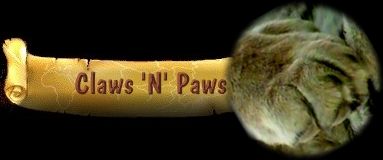
Claws, Paws & Pug Marks - Page 1&2: Claws| 3&4: Pug Marks | 5&6: Declawing

Claws, Paws & Pug Marks -
Page 1&2: Claws|
3&4: Pug Marks
| 5&6: Declawing
Retractable claws:Claws are usually described as retractable, however this is a misnomer. In their normal relaxed position claws are sheathed. This prevents wear from contact with the ground, and keeps them sharp. It is only during a stretch, such as that involved in catching prey, that the connecting tendons are pulled taut so automatically forcing the claws outwards. In other words, the action of extending the claws is not a conscious action.
|
The cheetah:The claws on the cheetah are slightly different from those of the tiger (or other cats) and are often described as being non-retractable. This is actually incorrect. All the usual ligaments found in other cats are present in the cheetah, however this cat has no protective sheaths of skin covering the claws so that they are clearly visible at all times, even when in a relaxed position. They may be seen in the image shown above. The shape of the claws is also different; they are much shorter and straighter in the cheetah (an exception to this is the dew claw which grows long, curled and sharp to aid in hunting). |
|
Claws, Paws & Pug Marks - Page 1&2: Claws| 3&4: Pug Marks | 5&6: Declawing Taxonomy
| Whiskers
| Hearing & Ear Spots | Eyesight
| Smell | Teeth
| Communication | Flehman
| Genetics | |
|
Photography
With Thanks To The Feline
Conservation Center (Photo 1) |